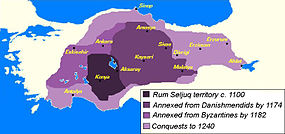Sultans of Rum
| Sultanate of Rum | ||||||||||||||||||||||||
|
Anadolu Selçuklu Devleti سلجوقیان روم Saljūqiyān-i Rūm |
||||||||||||||||||||||||
| Sultanate | ||||||||||||||||||||||||
|
||||||||||||||||||||||||
|
Flag
|
||||||||||||||||||||||||
|
Expansion of the Sultanate c. 1100–1240
|
||||||||||||||||||||||||
| Capital |
Nicaea (İznik) Iconium (Konya) Sivas |
|||||||||||||||||||||||
| Languages |
Persian (official, court, literature) Old Anatolian Turkish Greek (court/chancery) |
|||||||||||||||||||||||
| Religion | Sunni Islam (Official) | |||||||||||||||||||||||
| Political structure | Sultanate | |||||||||||||||||||||||
| Sultan | ||||||||||||||||||||||||
| • | 1077–1086 | Suleiman ibn Qutulmish | ||||||||||||||||||||||
| • | 1303–1308 | Mesud II | ||||||||||||||||||||||
| History | ||||||||||||||||||||||||
| • | Division from the Seljuq Empire | 1077 | ||||||||||||||||||||||
| • | Battle of Köse Dağ | 1243 | ||||||||||||||||||||||
| • | death of Mesud II | 1308 | ||||||||||||||||||||||
| • | Karamanid conquest | 1328 | ||||||||||||||||||||||
| Area | ||||||||||||||||||||||||
| • | 1243 | 400,000 km2 (150,000 sq mi) | ||||||||||||||||||||||
|
||||||||||||||||||||||||
The Sultanate of Rûm (also known as Rûm sultanate Persian: Saljūqiyān-i Rūm سلجوقیان روم, Anatolian Seljuk Sultanate, Sultanate of Iconium, Anatolian Seljuk State Turkish: Anadolu Selçuklu Devleti or Turkey Seljuk State Turkish: Türkiye Selçuklu Devleti) was a Turko-PersianSunni Muslim state, established in the parts of Anatolia which had been conquered from the Byzantine Empire by the Seljuk Empire which was established by Seljuk Turks. The name Rûm reflects the Arabic name of Anatolia, الرُّومُ ar-Rūm, a loan from Greek Ρωμιοί "Romans".
The Sultanate of Rum seceded from the Great Seljuk Empire under Suleiman ibn Qutulmish in 1077, following the Battle of Manzikert, with capitals first at İznik and then at Konya. It reached the height of its power during the late 12th and early 13th century, when it succeeded in taking Byzantine key ports on the Mediterranean and Black Sea coasts. In the east, the sultanate absorbed other Turkish states and reached Lake Van. Trade from Iran and Central Asia across Anatolia was developed by a system of caravanserai. Especially strong trade ties with the Genoese formed during this period. The increased wealth allowed the sultanate to absorb other Turkish states that had been established in eastern Anatolia (Danishmends, Mengujekids, Saltukids, Artuqids).
...
Wikipedia


